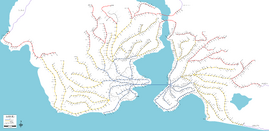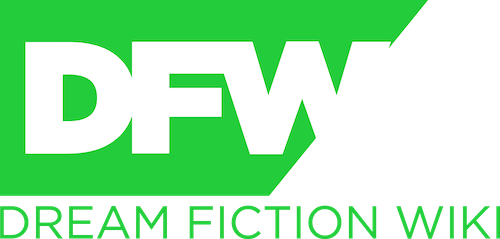
Map of the El Kadsre City railway system
El Kadsre Metro is the El Kadsre City train branch of PTEK which serves as operator of the electrified suburban passenger service in the El Kadsre City railway network which began operations in 1865.
History[]
In 1862, a public meeting was called for New Japan's first railway network which would link between New Edo (now El Kadsre City) and Ito En. Work began in January 1863 and was completed in 1865. Sometime later, the metropolitian railway network began to grow, and by 1880, New Edo had eight lines, which were Soudaka, Natashima (now Battsogt), Surao, Kiradao (Now Dunwich), Kimokanai, Watakotan, Avohkah and Minatocho (closed in 1911).
In 1910, the New Edo passenger railway network was electricfied and at the same time, the Brown Swingers, the first electirc passenger train, was introduced.
In 1974, the Public Transport Authority of the Vlokozu Union reviewed complaints about traffic problems in El Kadsre City, and decided to begin building a underground subway system in the El Kadsre City central business district. Construction began in 1975 and ended in 1978, and the El Kadsre Metro Tunnel opened to the public in March 1, 1979 with the first batch of lines (most met at City Central), initially operating with EKCM M20 along with Makato and EKCM D10 stocks. From 1982-1984, a second batch of lines was built; these lines opened in 1985, and were run by the Makato stock, as well as the M20 and M21 stocks, built by Takusa. Later on, EKCM M22 stock was introduced, built by Metro-Cammell.
In 1994, PTEK purchased two of the London Underground 1986 Stock prototypes (specifically the Blue and Red trains) from the London Passenger Transport Board. The Blue Train was joined with a set of licensed London Underground 1992 Stock units built by A. Hougaard & Co. and classed as A10 stock, while the Red Train was joined with a set of so-called "clones" built by the Red Train's manufacturer Metro-Cammell and classed as A11 stock. That same year, lines from the third batch, built from 1990-1993, were opened and were initially run by 4D, D10, A10 and M23 stock.
Lines[]
Main article: List of lines of the El Kadsre City Metro
Rolling Stock:[]
The Rolling Stock Include
Single-deck[]
- EKCM M21 (1982-present)
- EKCM M22 (1986-present)
- EKCM M23 (North Eastern lines) (1994-present)
- EKCM M24 (Yakuhaba, Jalro and Aleppa Lines) (2005-present)
- EKCM M25 (2014-present)
- EKCM M26 (Takasville, Guarinto and Airport Lines) (2019-present)
- EKCM A10 (Bulturuun and Yahahama Lines) (1993-present)
- EKCM A11 (Axelham and Bradford Lines) (1993-present)
- EKCM A12 (Urashiri, Abamaroa and Barkamsted Lines) (1998-present)
- EKCM A13 (Queenstown, San Lutor and Taribee Lines) (2007-present)
- EKCM A14 (2015-present)
- EKCM A15 (2021-present)
- EKCM B10 (Lesokoula, Cobona, and Rivermouth Lines) (1990-present)
- EKCM B11 (1995-present)
- EKCM B12 (University, Aleppa and Queenstown lines) (2000-present)
- EKCM B13 (2005-present)
- EKCM B14 (2018-present)
Double-deck[]
- EKCM 4D (1987-present)
- EKCM 5D (2011-present)
- EKCM D10-2 (University, Axelham, and Lasejo Lines) (1979-present)
- EKCM D11 (1993-present)
- EKCM D12 (Okuhidaka, Wingston and Queenstown Lines) (2000-present)
- EKCM D13 (Axelham and Bradford lines) (2012-present)
Work train fleet[]
Former fleet[]
- Brown Swingers (1910-1979)
- Red Carriers (1932-1987)
- Makato (1954-1987)
- EKCM M20 (1971-2016)
- EKCM D10 (1976-2020)
Fares And Daily Ridership[]
Daily Ridership: The Metro's Current Daily Ridership is 833,456 people per Operation.
Like other PTEK’s affiliated metro systems, El Kadsre City Metro uses the Togo ticketing system.
When EKCM was formed in 1979, it used the traditional paper ticketing system before switching over to the intergraded ticketing system known as TCard in 1986. The Togo ticketing system was introduced in 2003 and in 2007, the TCard ticketing system was decommissioned.
Fares:
- Single Journey: EK $2.55
- Concession Single Journey: EK $1.25
- LocalRail Silver EK $15/ride
- LocalRail Gold EK $20/ride
- LocalRail Platinum EK $25/ride
- All ParkandGo Card Tiers 15EK$
Incidents[]
1979 Nagasunai station fire[]
- Main article: 1979 Nagasunai railway station fire
On September 3, 1979, the electrical spark caused one of the Brown Swingers carriages to catch on fire, which left 48 people dead and 15 with third and fourth degree burns and the driver stopped the train at Nagasunai station. Although the Nagasunai station recived minor damages by a fire, the carrage was completely destroyed because of the fact the Brown Swingers were made of wood (though the Brown Swinger involved was later rebuilt using spare parts and now runs on the Kaowa Railway). As the result, the El Kadsre City Metro Tunnel was closed for two months and all Brown Swingers were pulled from service in the wake of the fire - the Brown Singers that weren't donated to museums or scrapped were rebuilt into the double-decker EKCM D10-2 units.
2000 bombing[]
- Main article: 2000 El Kadsre City Subway bombing
On May 15, 2000, two female suicide bombers from Gyönyörű Földünk detonated vests at two different stations during the morning rush hour. The attacks left 40 dead and 94 others wounded.
2001 bombings of Fujioka Square station[]
- Main article: 30 November 2001 El Kadsre bombings
On November 30, 2001, during rush hour, a bomb was detonated inside the EKCM M22 train just when it stops at the Fujioka Square.
